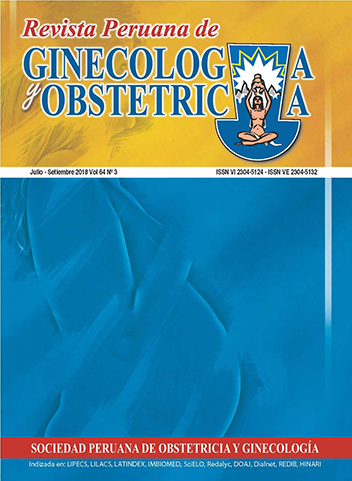Retronuchal cystic hygroma in the first trimester of pregnancy as a marker of chromosomal abnormalities
DOI:
https://doi.org/10.31403/rpgo.v64i2093Abstract
Background: Nuchal cystic hygroma is the most frequently identified marker of chromosomal anomalies during first trimester screening. Objective: To determine the association of the nuchal cystic hygroma with chromosomal anomalies diagnosed with karyotyping done between the first and second trimesters of pregnancy. Design: Retrospective study. Setting: Instituto Latinoamericano de Salud Reproductiva (ILSAR), Lima, Peru. Patients. Fetuses with nuchal cystic hygroma. Methods: The data were obtained from the ILSAR database between August 2007 and May 2018, the cases diagnosed by ultrasound from week 11 to 13.6. Nuchal cystic hygroma was defined as the presence of septated liquid content in the nuchal axial section with a thickness above the 95th percentile value for increased nuchal translucency value for the crown-rump length. The karyotype was obtained between the first and second trimesters from material collected by chorionic villus sampling (BVS) or amniocentesis (AMC). Main outcome measures: Karyotyping results were compared between cases with cystic hygroma alone and cases with cystic hygroma in addition to another marker. Results: Out of 459 invasive procedures performed in fetuses with high risk for chromosomal anomalies based on the Fetal test database of Spain, there were 162 cases of chromosomal anomalies (35.3%), and 104 cases of nuchal cystic hygroma (22.7%). Nuchal cystic hygroma was associated with a higher frequency of chromosomal abnormalities, compared to fetuses without cystic hygroma (52.9% vs. 30.1%; p<0.001). Out of 61 cases of hygroma alone, 42.3% had chromosomal anomalies, and when the hygroma was associated with other markers (fetal hydrops, abnormal ductus venosus, heart disease), 65.1% had chromosomal abnormalities. There was a statistically significant difference (p=0.003) for the presence of monosomy X between the group with cystic hygroma alone and the group with hygroma and fetal hydrops. There was no difference in hygroma thickness between the groups with and without chromosomal abnormalities. Conclusions: Nuchal cystic hygroma is a risk marker with high predictive value for chromosomal abnormalities, and its identification during prenatal screening may be considered an indication to a diagnostic test. When cystic hygroma is associated to flow abnormalities of the ductus venosus or fetal hydrops, chromosomal abnormalities significantly increase. The hygroma associated with hydrops was primarily linked to monosomy X, while the hygroma associated with abnormal flow velocity waveforms of the ductus venosus was linked to trisomy 21.Downloads
Download data is not yet available.
Downloads
Published
2018-09-28
How to Cite
Huamán Guerrero, M., Sosa Olavarría, A., Huamán J, M., & Díaz K, A. (2018). Retronuchal cystic hygroma in the first trimester of pregnancy as a marker of chromosomal abnormalities. The Peruvian Journal of Gynecology and Obstetrics, 64(3), 331–335. https://doi.org/10.31403/rpgo.v64i2093
Issue
Section
Artículos Originales
















